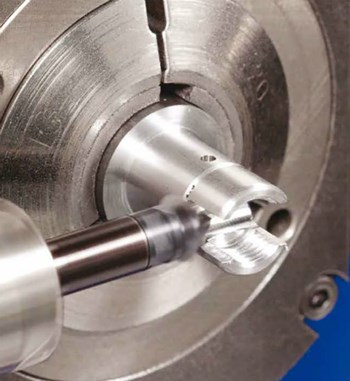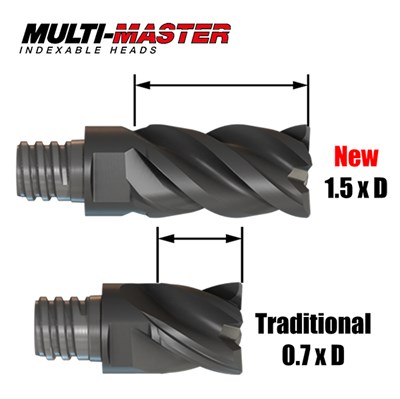Indexable Milling Tools for Driven Tool Stations on CNC Turning Centers
Sponsored ContentAs the milling capabilities of CNC turning centers improve, so too must the cutting tools. Here’s how to get more out of the live tooling on your turning equipment.
Share

The ability to use live tooling in a CNC turning center has been around for quite some time. This ability has enabled companies to complete parts in as few setups as possible (ideally one). The capability—power and speed—of rotary/driven tool stations has increased and, therefore, raised the bar in terms of what’s possible when using these spindles.
Of course, cutting tool suppliers must adapt whenever spindle capabilities increase. And this is an area where ISCAR excels: cutting tool innovation, which is exemplified in its new line of LOGIQ line of cutting tools.
Typically, solid carbide round tools (drills and endmills) are the cutting tools of choice for driven tool applications. This is due, for the most part, to the constraints of workspace and the machine/driven spindle capability, as well as the small-sized part features being machined; these challenges limit the implementation of conventional indexable tooling. This led ISCAR to design a new generation of indexable tooling technologies that effectively support the milling applications being addressed with driven spindles.
ISCAR’S NANMILL fully utilized in a Swiss milling application.
A great fit for this environment, these new indexable and interchangeable cutting tools are expected to provide gains in productivity with design characteristics such as:
- Tool designs capable of more than one type of application (facing, shouldering, etc.);
- Small (nano and micro) tooling and inserts that allow for more flutes in smaller diameter cutter bodies (down to 0.312");
- Interchangeable designs (such as with Multi-Master heads) that allow for quick, accurate tool/head changes.
These benefits all add up to improved utilization and making more out of what you pay for.
Interchangeable Solid Carbide Heads
In manufacturing, accuracy should be a given. When you introduce a “connection” into any component, maintaining accuracy can become more difficult. However, in cutting tool terms, if you can pull off accuracy in an interchangeable system while maintaining excellent rigidity, you can consider that a success.

This is the case with ISCAR’s Multi-Master system and what makes the system an ideal choice in rotary/driven tool stations. In its current form, the Multi-Master system provides users with more than 40,000 potential combinations, including a wide variety of interchangeable heads that can be used with shanks of various types and lengths for slotting, shouldering, chamfering and more, all while maintaining accuracy and rigidity.
Shank types include steel, carbide and heavy metal in both straight and conical taper iterations. Multi-Master is being further expanded to include 90-degree heads with 1.5ˣD length of cut, which is double the length of options offered for the past 15 years.
Because of the number of flutes in their design, the newly added heads for facing (FM type) drastically increase productivity while producing excellent surface quality. These heads can perform effective shoulder milling, as well. By adding Multi-Master to your cutting tool options for driven/rotary spindles users can reap the benefits of quick changeability and error proofing, all while maintaining a high level of accuracy and productivity.
Nano-, Micro-Sized Indexable Milling Inserts

Nano- and micro-sized end mills and drills, made from solid carbide rod, have been in the market for years. ISCAR has recently introduced nano- and micro-sized indexable inserts. The ability to press these very small inserts has opened the door for production of the smallest diameter, multi-flute, indexable milling tools ever produced.
ISCAR can now produce a 0.312" diameter, with two flutes, capable of taking a 1/8" depth of cut. Just consider how many times you’ve seen someone take 0.100" or less with a tool/insert that’s capable of much more. Bottom line, the most popular 90-degree indexable insert sizes are capable of approximately a ½" depth of cut. If you’re consistently using 0.100" of 0.500", you’re underutilizing 80% of what you paid for.

Spindle output characteristics—such as HP, torque and speed—are other important aspects for optimizing cutting tool utilization. It is not uncommon for stations to perform 10,000 RPM and upwards of 5HP in a short time period, and although the capability of rotary/driven spindles continues to improve, most will be better suited for utilizing smaller diameter cutting tools. It is also important to note that the part features typically machined in this environment are relatively small. For these reasons, ISCAR’s nano/micro milling tools make a good match, enabling users to better utilize the full 100% capacity of the tool.
Slitting
While not as common as conventional milling and drilling, slitting is also another operation performed with driven stations. To allow for an indexable approach, ISCAR has introduced the narrowest indexable slitting line available.

ISCAR SlimSlit offers an indexable slitting line down to 0.024" wide. Previously, it was only possible to perform a slitting operation under 0.040" with HSS (high-speed steel) or solid carbide slitting saws that required regrinding.
Regrinding changes the diameter, thus the potential need for slight programming changes or offsets. ISCAR’s SlimSlit line eliminates the need for additional setups by utilizing indexable inserts.
In addition to reducing setups, SlimSlit offers another advantage over HHS and solid carbide: chipformers that allow higher chip loads, which enables higher table feeds, further reducing cycle time. Currently, ISCAR offers SlimSlit in widths of 0.024", 0.031", 0.039" and 0.047"; and diameters of 1.260", 1.575", 1.968" and 2.480". With a variety of offerings, SlimSlit not only reduces number of setups but also simplifies tooling inventory and eliminates the need for regrinding the tools.
ISCAR’s newly launched the LOGIQ line of tools creates new options for the lathe with driven tooling stations that were unavailable until recently. Use of indexable tooling in this small work space environment produces many benefits—economy, simplicity of tool management, reduction of potential errors when renewing the tooling and more efficient use of the carbide materials. With an increasing demand to do more in one set up paired with the trend to make smaller, lightweight final products, ISCAR is thinking forward to provide the best machining economics.
In an industry where every second makes a difference and every movement counts, an innovative approach to even the most basic cutting tool can contribute to increased productivity, less waste, and ultimately lower cost per part.
Go to ISCAR.com for more information.